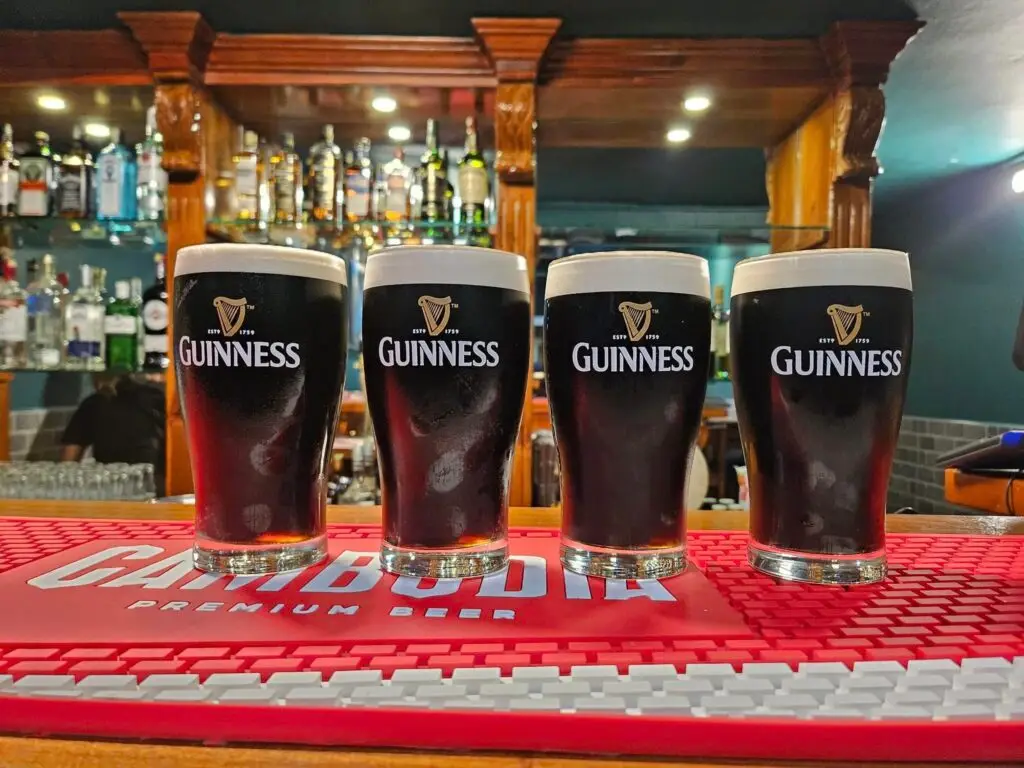Guinness


Guinness
Guinness iconic Irish stout has been produced at Dublin’s legendary St. James’s Gate Brewery since 1759. This milestone was marked by Arthur Guinness’s ambitious decision to commence his brewing venture by securing an extraordinary 9,000-year lease on the expansive four-acre site. Historical documents suggest that another brewery previously operated at this location starting from 1670. Initially, Arthur Guinness focused on brewing ale. However, as the popularity of a new beer style, known as porter, began to surge, Guinness adeptly adapted to meet this emerging demand.
By 1779, the brewery was recognized as one of only two official providers of beer and ale to Dublin Castle, the governmental hub. Just five years later, Guinness had secured its position as the sole supplier of porter to this prestigious institution. By 1799, the brewery had phased out ales entirely, dedicating itself to the production of robust, darker beers. Guinness’s rise to preeminence continued, and by 1838, it had become Ireland’s largest brewery.
By 1886, it was producing an impressive 1.2 million barrels annually, earning the title of the world’s largest brewery. Though the company remained family-run over five generations, the latter half of the 20th century witnessed significant ownership transitions. Today, the iconic Guinness brand is part of Diageo, a leading British multinational alcoholic beverage company.
Popular Guinness Varieties
Guinness Extra Stout
Subtly fruity notes of fermentation with a dry finish. Available in bottles
Guinness Foreign Extra Stout
Introduced as West India Porter around 1800, winning loyalty in Africa, Asia, and the Caribbean. Today it accounts for 45% of Guinness’s global sales. This older style of stout has nearly twice the alcohol of draft Guinness, with a tart, refreshing flavor emphasizing the fruity notes of the roasted malt. Available in bottles. Until recently, Guinness Foreign Extra Stout was available (brewed locally in Cambodia by Cambrew Ltd), but this seems to be out of stock everywhere at the minute.
Guinness Draught
Smooth and creamy with balanced bittersweet flavor accented with roasted coffee and malt. Available in kegs & cans. Sadly, there is no draught Guinness on tap anywhere in Cambodia at this time. But all is not lost – you can find draught Guinness cans that were made in Ireland!
Guinness Draught from a Can?
Message from Guinness:
“You might have always thought to yourself that there’s no way you could replicate the Guinness draught experience in can. Well, that’s where you’re wrong. Poured correctly, and the result is a perfectly smooth beer that’s unmistakably Guinness.
Our Global Head of Quality Steve Gilsenan has honed the craft so you can enjoy that same great tasting Guinness from the comfort of your own home. The real question is, are you a classic pourer or a hard pourer?
To achieve the classic pour, get yourself a clean pint glass and hold it at a 45-degree angle. Begin to slowly pour your Guinness Draught in a Can off the side of the glass. As it fills, slowly tilt your glass upwards until it is vertical. Let it settle and enjoy!”
Source: www.guinness.com (1)
What’s a pint of Guinness?
Guinness stout is crafted using four essential and historic ingredients, each playing a pivotal role in shaping its distinctive taste and character. The first ingredient is water, which acts as the foundation and is sourced from natural springs near the brewery, ensuring purity and quality. Next, cereal grains, primarily barley. The barley is malted and roasted, providing the rich, dark color and malty flavors that define Guinness. This roasting process contributes to the brew’s unique bitterness and depth.
Spices, although not specified, typically include hops, which are critical in adding aroma and a balancing bitterness to the stout, enhancing its complexity. Yeast, the fourth ingredient, is the living organism responsible for fermenting the sugars from the grains, transforming them into alcohol and carbon dioxide, and contributing to the subtle nuances in flavor. Although not traditionally an ingredient, nitrogen gas became integral to Guinness beers in the late 1950s. This innovation allows the stout to achieve its iconic, smooth creaminess and creates a delightful, velvety texture with a cascading effect when poured.
What Is Guinness with a Widget?
The evolution of Guinness draught, or draft in American English, represents a fascinating chapter in brewing history. The innovative turning point came in 1959 when Guinness pioneered a groundbreaking nitrogen dispensing system. This system, distinctively different from conventional draft beer systems relying solely on carbon dioxide, uses nitrogen to deliver finer, smaller bubbles. The result is a creamy, velvety texture and a distinctive blond head, setting Guinness apart from other beers.
This nitrogen technique has since been embraced by craft brewers in the United States and globally, who seek to replicate this subtle texture and evenly layered flavors. The nitro tap creates a stark contrast to carbon-dioxide-based draft systems, which tend to highlight sharper aromas and create a more effervescent experience.
Further innovation occurred in the 1980s when Guinness introduced a canned version of their draught, complete with a specially engineered widget. This ingenious device simulates the effects of a traditional nitrous tap upon opening, releasing nitrogenized bubbles that ensure each sip remains rich and consistent, even when poured from a can. This advancement allowed beer enthusiasts to enjoy the authentic taste and texture of Guinness draught at home, underscoring the brand’s commitment to delivering a high-quality drinking experience.
Is Guinness Really Good for You?
In the 1920s, Guinness launched its iconic advertising slogan, “Guinness is good for you.” While this catchy phrase might not make a scientifically verified health claim, it does highlight some interesting facts about the beverage. Beer, including Guinness, is known to include B vitamins, soluble fiber, and prebiotics—nutrients that indeed contribute positively to health. What sets Guinness apart, however, is its antioxidant content, which is similar to that found in red wine and dark chocolate. These antioxidants are not typically present in other types of beer. Research conducted by the University of Wisconsin has indicated that, much like wine, consuming Guinness can aid in reducing blood clots and therefore may lower the risk of a heart attack. In light of these findings, there is a degree of truth in saying Guinness can be beneficial for your health.
The Guinness Storehouse
The Guinness Storehouse, situated in the heart of Dublin, is a monumental museum dedicated to the famed Irish stout, Guinness. Originally a brewing facility, it has been transformed into a seven-story attraction revolving around a stunning glass atrium that is ingeniously shaped like a pint of Guinness, inviting visitors to embark on an immersive journey through the rich history and brewing craft of this iconic beverage. The experience begins on the ground floor, where guests are introduced to the four fundamental ingredients that create Guinness: water, barley, hops, and yeast. These essential elements are beautifully displayed alongside a tribute to the brewery’s visionary founder, Arthur Guinness. As visitors ascend through the various levels, they explore in detail the company’s storied past, the intricate brewing processes, and the evolution of its renowned advertising campaigns. The tour reaches its climax at the renowned Gravity Bar on the seventh floor, which offers panoramic views of Dublin through its glass walls, providing the perfect setting to savor a perfectly poured pint of Guinness.
The Gravity Bar invites visitors to savor a pint of Guinness while taking in a nearly 360-degree panorama of Dublin and the working 64-acre brewery below. Other Storehouse attractions include the Perfect Pint bar, where visitors may pour their own pint with expert coaching — a carefully prescribed process that takes nearly two minutes. Also on site are several restaurants and a copy of the 9000-year lease, now void: Guinness bought the property many years ago.
Alternatives to Guinness in Phnom Penh
There is no shortage of stout beer in Phnom Penh and there are many alternatives to Guinness draught, including but not limited to Angkor Extra Stout, Black Panther Foreign Extra Stout, ABC Extra Stout and Hanuman Black!
Guinness in Phnom Penh
If you fancy a Guinness in Phnom Penh Cambodia then head on down to The Wild Rover on St 178 in Phnom Penh! Our glasses were custom made to suit the 440mg draught Guinness cans. Shaped perfectly to form a proper, lasting creamy head!



